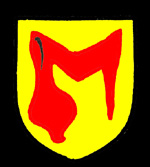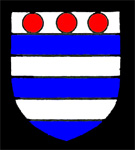Morin Family
Historians suggest that by 1068 most of England was in the ownership of as few as nine all powerful Norman families. These magnates could in turn reward their own supporters by making small gifts or sub-letting some of their holdings. Such was the case in Bedfordshire. After the Conquest of 1066 most of the County had been given to the more powerful families of the Countess Judith (the Conqueror’s niece), Beauchamp, Taillebosc, de Aubigny, and Mowbray. In the years following, however, the immigration of lesser known Norman families increased rapidly and other now familiar names began to be recorded. Amongst these were the Morins who settled in the Harrold area.
Reference to a Ralph de Morin is found in Bedford in 1180. He married heiress Albreda de Braose in 1194, and with his marriage acquired lands including property in Harrold held from the heirs of Countess Judith as part of the Honour of Huntingdon. In 1194 Simon de Blosseville, another tenant of the Honour of Huntingdon who then held Harrold Manor, recognised and acknowledged the right of Ralph Morin to four hides of land in the Parish, and this appears to have been the beginning of this family’s rise up the social and land owning classes. Soon after, Ralph paid to the Sheriff of Bedfordshire, sixty two shillings and a penny, the first part of his knight’s fee calculated according to the size of his land holdings. Among the lands that Morin acquired in 1207 was a part of the Parish of Ravensden, including the former hill fort now known as Mowsbury Hill. On this ancient site he constructed a large wooden moated Manor House and this soon became known as Morinsbury or Mowsbury Castle.
The first Ralph Morin probably died between 1208 and 1213; he was succeeded by his son, another Ralph. This second Ralph Morin fought against King John in 1216, and was one of the knights forced to surrender in Belvoir Castle (Leicestershire) when John threatened to starve the castle’s owner to death. Ralph forfeited his lands, but they were returned to him in 1217. Besides his Bedfordshire lands he held land in Buckinghamshire, Surrey, Somerset, Devon, Kent and Northamptonshire. In 1232 he reached an agreement with Simon de Blosseville over the four hides of land in Harrold which appears to have ended the Blosseville’s association with that manor. In 1235 Ralph Morin was recorded as holding two knight’s fees in Harrold from the Honour of Huntingdon. He probably died in 1254.

The Hastings Family coat of arms
Ralph was succeeded by his son John, who was dead by 1263, leaving his son, another Ralph, as his heir. Ralph was a minor and he was put into the wardship of his overlord at Harrold, Sir Henry Hastings. When Hastings was wounded and captured at the battle of Evesham, his lands were forfeited, but restored in 1267. Ralph Morin married Isabel, sister and co-heir of John, son of Oliver de Lovetot. In 1275 he was imprisoned in Oxford Gaol on suspicion of having lost a gerfalcon of the King, but he was released when it was found.

The de Grey Family coat of arms
Throughout the 13th century the Morin family were in debt to Jewish moneylenders, and they appear to have mortgaged their land at Harrold to the de Grey family of Ruthin, who held the Manor of Wrest at Silsoe. In 1287 John de Grey held the land on a life lease, but by 1330 the family appear to have given up their rights to the lordship of the manor of Harrold. By the end of the 13th century ownership of Morinsbury Manor in Ravensden had passed to the Tyringham family.
The second Ralph Morin (who fought against King John in 1216) had a daughter who married John de Pabenham. Their descendants included three wives of Henry VIII - Anne Boleyn, Jane Seymour and Catherine Howard - and Elizabeth I and Edward VI. Thus within 10 generations, the family of de Morin moved from country squires to monarchs of the realm